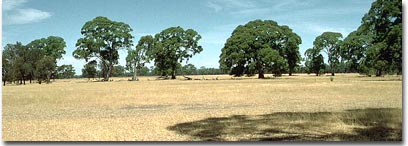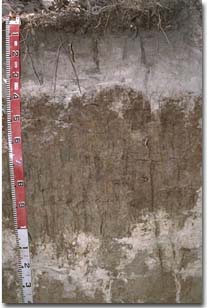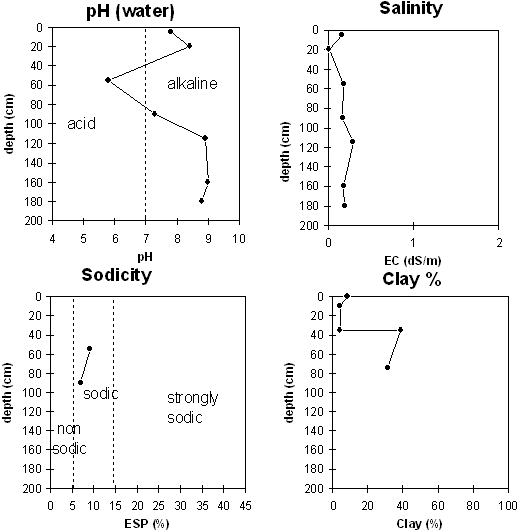Site WW15
Location: Lillimur South
Australian Soil Classification: Hypercalcic, mottled-Subnatric, Brown SODOSOL
Northcote Factual Key: Dy5.43
Great Soil Group: solodic
 Site WW15 Landscape |
General Landscape Description: Mid-slope on gently undulating plain. The landscapes in these units consist of gently undulating plains and gently undulating rises (closer spaced undulations). Ferric Sodosols may also occur in association with this soil type, particularly north of Apsley where this site is located.
Soil Profile Morphology:
Surface Soil
| A1 | 0-10 cm | Very dark greyish brown (10YR3/2) loamy sand; weakly structured; firm consistence when dry; pH 7.8; abrupt transition to: |  Site WW15 Profile |
| A2 | 10-35 cm | Light brown (7.5YR6/4) sand; conspicuously bleached when dry; structureless; very firm consistence when dry; a few ferruginised iron nodules; pH 8.4; sharp transition to: | |
| Subsoil | |||
| B21 | 35-75 cm | Yellowish brown (10YR5/4) light medium clay; many coarse distinct red mottles; strong prismatic structure (peds >200 mm) parting to prismatic and blocky structure (peds 20-50 mm), parting to moderate blocky structure (10-20 mm); dark organic staining on the faces of the prisms; strong consistence when dry; dispersive when worked; pH 5.8; clear transition to: | |
| B22 | 75-100 cm | Light grey (2.5Y7/2) light medium clay (fine sandy); with yellowish red mottles; same structure as horizon above; very firm consistence when slightly moist; dispersive when worked; pH 7.3; clear transition to: | |
| B23k | 100-130 cm | Light grey (2.5Y7/2) sandy clay; with strong brown mottles; very firm consistence when moderately moist; soft (and a few hard) calcium carbonate segregations are abundant (50%); pH 8.9: | |
| B3 | 130-180 cm | Light grey (2.5Y7/2) sandy clay (becoming light sandy clay loam at depth); with yellow mottles; structureless; firm consistence when moderately moist; pH 9.0: | |
| BC | 180-200 cm + | Loamy sand; structureless; weak consistence when moderately moist; pH 8.8. | |
Horizon | pH | Salinity | Internal Drainage | Hydro-phobicity | ||
Surface (A1 horizon) | slightly alkaline | low | non-sodic | - | - | moderate |
Subsoil (B21 horizon) | moderately acid | low | sodic | nil1 | Imperfectly drained2 | - |
Deeper subsoil (at 1 metre) | strongly alkaline | low-medium | sodic | nil1 | - | - |
2 Most impeding horizon of the profile that will affect plant growth.

Key Profile Features:
- Sandy surface soil.
- Hydrophobic surface soil.
- Bleached A2 horizon.
- Strong texture contrast between surface soil and subsoil.
- Top of the subsoil (B21) is acidic.
- Sodic subsoil.
- Prismatic structure.
- Mottled subsoil.
- Dispersive subsoil following cultivation when wet.
- Weathered sandstone occurs at 2m depth.
Soil Restrictions and Management Prescriptions:
Feature | Result | Management Prescription |
| Sandy surface soil. |
| Dryland cropping.
|
| Hydrophobic surface soil. |
|
|
| Bleached A2 horizon. |
| Dryland cropping.
|
| Strong textural contrast between surface soil and subsoil (duplex). |
|
|
| Acidic upper subsoil. |
|
|
| Sodic clay subsoil. |
|
|
| Columnar or prismatic subsoil structure. |
|
|
| Mottled subsoil. |
|
|
| Dispersion when reworked. |
|
|
Land Suitability Rating Table:
LAND USE | SUITABILITY CLASS | MAJOR LIMITING COMPONENT |
| Wheat | 2 | Climate, landscape, soil |
| Canola | 2 | Climate, landscape, soil |
| Chickpeas | 3 | Soil |
| Lentils | 3 | Soil |
| White clover seed | 2 | Landscape, soil |
| Lucerne for seed production | 3 | Soil |
| Viticulture | 3 | Soil |
| Apples | 2 | Climate, soil |
| Potatoes | 3 | Soil |
| Carrots | 3 | Soil |
| Onions | 3 | Soil |
| Sweet corn | 3 | Soil |
| Radiata Pine | 3 | Climate |
| Blue Gum | 3 | Climate |
Land Suitability Assessment and Primary Limitations:
| Wheat | Climate | 2 | Moderate frost risk, slightly high rainfall. |
| Landscape | 2 | Wind erosion hazard. | |
| Soil | 2 | Slightly impeded internal drainage, hydrophobicity. | |
| Canola | Climate | 2 | Moderate frost risk. |
| Landscape | 2 | Wind erosion hazard. | |
| Soil | 2 | Slightly impeded internal drainage, hydrophobicity, slightly acid subsoil pH | |
| Chickpeas | Climate | 2* | Moderate frost risk, moderate to high rainfall. |
| Landscape | 2 | Wind erosion hazard. | |
| Soil | 3 | Sandy surface soil, impeded internal drainage. | |
| Lentils | Climate | 2 | Moderate frost risk, slightly high rainfall. |
| Landscape | 2 | Wind erosion hazard. | |
| Soil | 3 | Sandy surface soil, impeded internal drainage. | |
| White clover seed | Climate | 1 | No major limitation. |
| Landscape | 2 | Wind erosion hazard. | |
| Soil | 2 | Sandy surface soil texture, soil salinity, slightly impeded internal drainage, hydrophobicity. | |
| Lucerne for seed production | Climate | 1 | No major limitation. |
| Landscape | 2 | Wind erosion hazard. | |
| Soil | 3 | Impeded internal drainage. | |
| Viticulture | Climate | 2 | Moderate frost risk. |
| Landscape | 1 | No major limitation. | |
| Soil | 3 | Impeded internal drainage. | |
| Apples | Climate | 2 | Moderate frost risk, slightly high mean maximum January temperature. |
| Landscape | 1 | No major limitation. | |
| Soil | 2 | Slightly alkaline surface soil pH, slightly acidic subsoil, soil salinity, slightly impeded internal drainage, hydrophobicity. | |
| Potatoes | Climate | 2 | Slightly high mean maximum January temperature. |
| Landscape | 2 | Wind erosion hazard. | |
| Soil | 3 | Impeded internal drainage. | |
| Carrots | Climate | 1 | No major limitation. |
| Landscape | 2 | Wind erosion hazard. | |
| Soil | 3 | Impeded internal drainage. | |
| Onions | Climate | 2 | Moderate frost risk. |
| Landscape | 2 | Wind erosion hazard. | |
| Soil | 3 | Impeded internal drainage. | |
| Sweet corn | Climate | 2 | Slightly low mean monthly temperature (October - March). |
| Landscape | 2 | Wind erosion hazard. | |
| Soil | 3 | Sandy surface soil texture. | |
| Radiata Pine | Climate | 3 | Low rainfall. |
| Landscape | 2 | Wind erosion hazard. | |
| Soil | 2 | Slightly alkaline subsoil pH, slightly impeded internal drainage, hydrophobicity. | |
| Blue Gum | Climate | 3 | Low rainfall. |
| Landscape | 2 | Wind erosion hazard. | |
| Soil | 2 | Slightly alkaline subsoil pH, slightly impeded internal drainage, hydrophobicity. |
Profile Described By: Mark Imhof, Nathalie Baxter (09/01/97).


